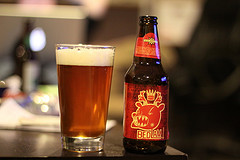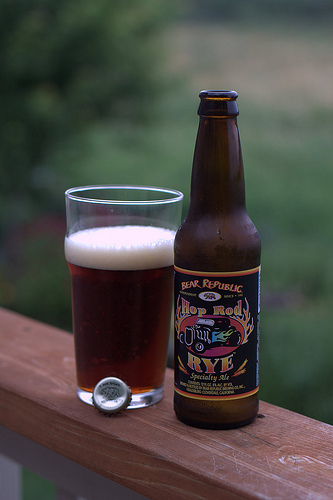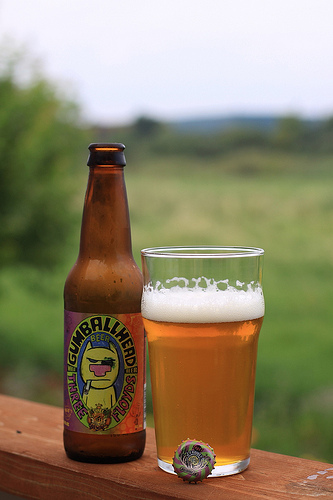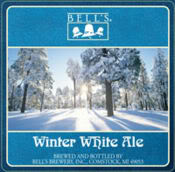As complex and varied as the flavor of beer is, it is actually only made up of just four key ingredients: Malt, Hops, Water and Yeast. Each of these ingredients has a role in the final product, and we’ll be reviewing each piece as a part of Beer 101. The first ingredient we’ll be discussing is malt.
Malt plays several roles in beer, from providing the sugars that allow for fermentation, to providing a base for the flavors. Before I go into more details about what malt does, let’s talk about what malt is.
When discussing malt in beer, the most common kind you’ll find is malted barley. Though it’s not the only malt suitable for making beer, barley has become the preferred grain for several reasons. One of the primary factors that made barley the malt of choice is that it’s not very good for grinding into flour. I’ll cover this in more depth in a future post in Beer 101 where we talk some beer history. We’ll also cover other grains used in beer in a future post.

Two Row Barley
Barley is a grain member of the grass family that grows in three varieties. Two, four and six row varieties refer to the number of seeds on the stalk. Two and six row barley are the only ones that are suitable for brewing, and brewers choose which type they will use in their beer for different reasons.
Two row barley is often selected because it malts better, and because it has a higher ratio of starch to husk than six row barley. Six row barley is used because it is cheaper than two row, and it produces more enzymes for converting starch into fermentable sugar during the malting process. This extra enzyme production is key when using other ingredients that don’t produce their own enzymes or don’t produce enough for effective brewing. Two row barley is the traditional brewer’s favorite, but six row barley is very common among U.S. craft brewers.
Barley by itself is not suitable for brewing and it must be malted before it is used in beer. Malting is the process that converts the starches in the barley into soluble starch, reduces proteins and generates yeast nutrients and enzymes that are important to brewing. Barley is malted by taking the harvested grain and soaking it in water to activate the dormant kernel. The kernels are then allowed to start germinating (sprouting roots). This germination is where the seeds naturally convert starch into soluble starch which would be used as food for the new plant. Since brewers are only interested in the malted barley, it is at this point that the grain is heated in a kiln to stop the further growth and dry it out.
 The next step in processing the barley is to roast it. Much like coffee beans are roasted, there are varying degrees to which the grains are roasted. If the barley is simply roasted to the point that it stops the germination process, it is considered pale malt. This pale malt is the lightest form of malt in terms of color, and has the most enzymes remaining. Pale malt is used as the base malt in many beers and many breweries add pale malt to every beer they brew because it provides a solid malt sweet backbone to the beer and is much cheaper than malts that have been roasted further. The high concentration of enzymes remaining in the malt is also very important to the rest of the brewing process.
The next step in processing the barley is to roast it. Much like coffee beans are roasted, there are varying degrees to which the grains are roasted. If the barley is simply roasted to the point that it stops the germination process, it is considered pale malt. This pale malt is the lightest form of malt in terms of color, and has the most enzymes remaining. Pale malt is used as the base malt in many beers and many breweries add pale malt to every beer they brew because it provides a solid malt sweet backbone to the beer and is much cheaper than malts that have been roasted further. The high concentration of enzymes remaining in the malt is also very important to the rest of the brewing process.
As the malt is roasted further, it becomes darker and different flavors are introduced. Amber, brown, chocolate and black malts are different varieties that are produced by heating the malt to a higher temperature. When the malt is further darkened, caramel and roast flavors come out, but the enzymes are also burned away.
After malting and roasting, the malt is ground into grist. This grist is then added to water and heated. This heating process starts the enzyme reaction and the starches in the grain are turned into sugar. This sugar is important because it is what the yeast will turn into alcohol and carbon dioxide later in the brewing process. The product of adding the grist to the water is known as sweet wort (unfermented beer).
 Malt is a crucial ingredient to the flavor of the beer. It adds the sweetness of the beer and provides a balance to the bitterness introduced by the hops. Malt also provides the sugars that are used in fermenting and allow for the creation of alcohol in the beer. The malt that is used in a beer is the most obvious difference between a pale beer and a stout beer.
Malt is a crucial ingredient to the flavor of the beer. It adds the sweetness of the beer and provides a balance to the bitterness introduced by the hops. Malt also provides the sugars that are used in fermenting and allow for the creation of alcohol in the beer. The malt that is used in a beer is the most obvious difference between a pale beer and a stout beer.
I hope that you learned something by reading this, and that you have a clearer understanding of one of the four main ingredients in beer. Stay tuned as my next Beer 101 post will cover another one of the main four ingredients of beer: hops. Again, if you have any questions, or clarifications, please feel free to comment, or send me a tweet.
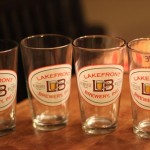
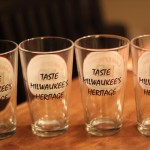

 The next step in processing the barley is to roast it. Much like coffee beans are roasted, there are varying degrees to which the grains are roasted. If the barley is simply roasted to the point that it stops the germination process, it is considered pale malt. This pale malt is the lightest form of malt in terms of color, and has the most enzymes remaining. Pale malt is used as the base malt in many beers and many breweries add pale malt to every beer they brew because it provides a solid malt sweet backbone to the beer and is much cheaper than malts that have been roasted further. The high concentration of enzymes remaining in the malt is also very important to the rest of the brewing process.
The next step in processing the barley is to roast it. Much like coffee beans are roasted, there are varying degrees to which the grains are roasted. If the barley is simply roasted to the point that it stops the germination process, it is considered pale malt. This pale malt is the lightest form of malt in terms of color, and has the most enzymes remaining. Pale malt is used as the base malt in many beers and many breweries add pale malt to every beer they brew because it provides a solid malt sweet backbone to the beer and is much cheaper than malts that have been roasted further. The high concentration of enzymes remaining in the malt is also very important to the rest of the brewing process. Malt is a crucial ingredient to the flavor of the beer. It adds the sweetness of the beer and provides a balance to the bitterness introduced by the hops. Malt also provides the sugars that are used in fermenting and allow for the creation of alcohol in the beer. The malt that is used in a beer is the most obvious difference between a pale beer and a stout beer.
Malt is a crucial ingredient to the flavor of the beer. It adds the sweetness of the beer and provides a balance to the bitterness introduced by the hops. Malt also provides the sugars that are used in fermenting and allow for the creation of alcohol in the beer. The malt that is used in a beer is the most obvious difference between a pale beer and a stout beer.